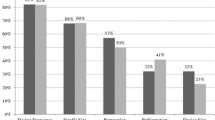Abstract
Understanding user needs is essential to design biomedical devices that are efficacious in real life (clinically effective). Few studies propose analytic quantitative methods to elicit user needs. This paper presents a preliminary application of the Analytic Hierarchy Process (AHP) to elicit user needs. As a case study we focused on the use of a biomedical device for auto-injection of epinephrine to treat severe allergic reactions. Although the study presented is on-going, the methods we describe provide valuable insights into how quantitative methods can be applied to user needs elicitation.
Access this chapter
Tax calculation will be finalised at checkout
Purchases are for personal use only
Preview
Unable to display preview. Download preview PDF.
Similar content being viewed by others
References
Bombardier, C., Maetzel, A.: Pharmacoeconomic evaluation of new treatments: efficacy versus effectiveness studies? Annals of the Rheumatic Diseases 58(suppl. 1), 182–185 (1999)
Martin, J.L., Barnett, J.: Integrating the results of user research into medical device development: insights from a case study. BMC Medical Informatics and Decision Making 12, 74 (2012), doi:10.1186/1472-6947-12-74
Simons, K.J., Simons, F.E.R.: Epinephrine and its use in anaphylaxis: current issues. Current Opinion in Allergy and Clinical Immunology 10(4), 354–361 (2010), doi:10.1097/Aci.0b013e32833bc670
Cummings, A.J., Knibb, R.C., Erlewyn-Lajeunesse, M., King, R.M., Roberts, G., Lucas, J.S.A.: Management of nut allergy influences quality of life and anxiety in children and their mothers. Pediat Allerg Imm-Uk 21(4), 586–594 (2010), doi:10.1111/j.1399-3038.2009.00975.x
Pumphrey, R.: When should self-injectible epinephrine be prescribed for food allergy and when should it be used? Current Opinion in Allergy and Clinical Immunology 8(3), 254–260 (2008), doi:10.1097/ACI.0b013e3282ffb168
Bracale, U., Rovani, M., Picardo, A., Merola, G., Pignata, G., Sodo, M., Di Salvo, E., Ratto, E.L., Noceti, A., Melillo, P., Pecchia, L.: Beneficial effects of fibrin glue (Quixil) versus Lichtenstein conventional technique in inguinal hernia repair: a randomized clinical trial. Hernia (2012), doi:10.1007/s10029-012-1020-4
Bracale, U., Rovani, M., Bracale, M., Pignata, G., Corcione, F., Pecchia, L.: Totally laparoscopic gastrectomy for gastric cancer: Meta-analysis of short-term outcomes. Minim. Invasive Ther. Allied Technol. 21(3), 150–160 (2011), doi:10.3109/13645706.2011.588712
Bracale, U., Rovani, M., Melillo, P., Merola, G., Pecchia, L.: Which is the best laparoscopic approach for inguinal hernia repair: TEP or TAPP? A network meta-analysis. Surgical Endoscopy 26(12), 3355–3366 (2012), doi:10.1007/s00464-012-2382-5
Leys, M.: Health care policy: qualitative evidence and health technology assessment. Health Policy 65(3), 217–226 (2003), doi:10.1016/S0168-8510(02)00209-9
Saaty, T.L., Vargas, L.G.: Models, methods, concepts & applications of the analytic hierarchy process. International series in operations research & management science, vol. 34. Kluwer Academic Publishers, Boston (2001)
Liberatore, M.J., Nydick, R.L.: The analytic hierarchy process in medical and health care decision making: A literature review. European Journal of Operational Research 189(1), 194–207 (2008), doi:10.1016/j.ejor.2007.05.001
Pecchia, L., Craven, M.P.: Early stage Health Technology Assessment (HTA) of biomedical devices. In: Long, M. (ed.) World Congress on Medical Physics and Biomedical Engineering. IFMBE Proceedings, vol. 39, pp. 1525–1528. Springer, Heidelberg (2013)
Dolan, J.G.: Are Patients Capable of Using the Analytic Hierarchy Process and Willing to Use It to Help Make Clinical Decisions. Medical Decision Making 15(1), 76–80 (1995), doi:10.1177/0272989x9501500111
Muraro, A., Roberts, G., Clark, A., Eigenmann, P.A., Halken, S., Lack, G., Moneret-Vautrin, A., Niggemann, B., Rance, F., Tfac, E.: The management of anaphylaxis in childhood: position paper of the European academy of allergology and clinical immunology. Allergy 62(8), 857–871 (2007), doi:10.1111/j.1398-9995.2007.01421.x
Choo, K., Sheikh, A.: Action plans for the long-term management of anaphylaxis: systematic review of effectiveness. Clin. Exp. Allergy 37(7), 1090–1094 (2007), doi:10.1111/j.1365-2222.2007.02711.x
Ewan, P.W.: ABC of allergies - Anaphylaxis. Brit. Med. J. 316(7142), 1442–1445 (1998)
Gupta, R., Sheikh, A., Strachan, D.P., Anderson, H.R.: Time trends in allergic disorders in the UK. Thorax 62(1), 91–96 (2007), doi:10.1136/thx.2004.038844
Sheikh, A., Hippisley-Cox, J., Newton, J., Fenty, J.: Trends in national incidence, lifetime prevalence and adrenaline prescribing for anaphylaxis in England. Journal of the Royal Society of Medicine 101(3), 139–143 (2008), doi:10.1258/jrsm.2008.070306
Baral, V.R., Hourihane, J.O.: Food allergy in children. Postgraduate Medical Journal 81(961), 693–701 (2005), doi:10.1136/pgmj.2004.030288
Bock, S.A., Munoz-Furlong, A., Sampson, H.A.: Fatalities due to anaphylactic reactions to foods. J. Allergy Clin. Immun. 107(1), 191–193 (2001), doi:10.1067/mai.2001.112031
Simons, F.E.R.: First-aid treatment of anaphylaxis to food: Focus on epinephrine. J. Allergy Clin. Immun. 113(5), 837–844 (2004), doi:10.1016/j.jaci.2004.01.079
Money, A.G., Barnett, J., Kuljis, J., Lucas, J.: Patient perceptions of epinephrine auto-injectors: exploring barriers to use. Scandinavian Journal of Caring Sciences (2012), doi:10.1111/j.1471-6712.2012.01045.x
Pecchia, L., Bath, P.A., Pendleton, N., Bracale, M.: Web-based system for assessing risk factors for falls in community-dwelling elderly people using the analytic hierarchy process. International Journal of the Analytic Hierarchy Process 2(2), 135–157 (2010)
Pecchia, L., Bath, P.A., Pendleton, N., Bracale, M.: Analytic Hierarchy Process (AHP) for Examining Healthcare Professionals’ Assessments of Risk Factors The Relative Importance of Risk Factors for Falls in Community-dwelling Older People. Methods Inf. Med. 50(5), 435–444 (2011), doi:10.3414/Me10-01-0028
Pecchia, L., Martin, J.L., Ragozzino, A., Vanzanella, C., Scognamiglio, A., Mirarchi, L., Morgan, S.P.: User needs elicitation via analytic hierarchy process (AHP). A case study on a Computed Tomography (CT) scanner. BMC Med. Inform. Decis. Mak. 13(1), 2 (2013), doi:10.1186/1472-6947-13-2
Author information
Authors and Affiliations
Editor information
Editors and Affiliations
Rights and permissions
Copyright information
© 2013 Springer-Verlag Berlin Heidelberg
About this paper
Cite this paper
Pecchia, L., Martin, J.L., Money, A.G., Barnet, J. (2013). Application of Analytic Hierarchy Process for User Needs Elicitation: A Preliminary Study on a Device for Auto-injection of Epinephrine. In: Huang, G., Liu, X., He, J., Klawonn, F., Yao, G. (eds) Health Information Science. HIS 2013. Lecture Notes in Computer Science, vol 7798. Springer, Berlin, Heidelberg. https://doi.org/10.1007/978-3-642-37899-7_23
Download citation
DOI: https://doi.org/10.1007/978-3-642-37899-7_23
Publisher Name: Springer, Berlin, Heidelberg
Print ISBN: 978-3-642-37898-0
Online ISBN: 978-3-642-37899-7
eBook Packages: Computer ScienceComputer Science (R0)




